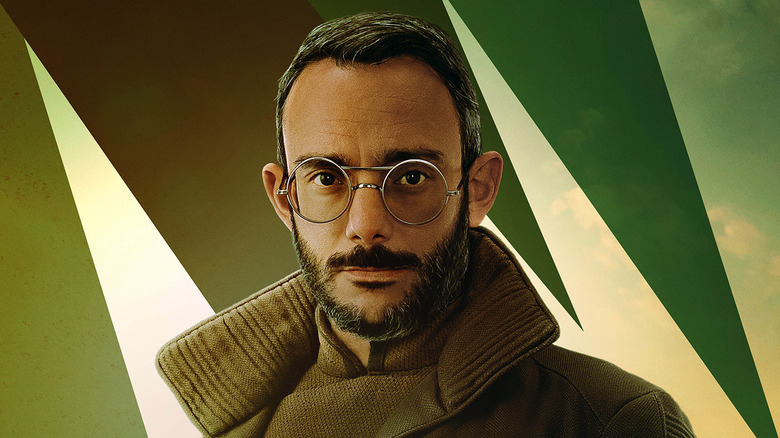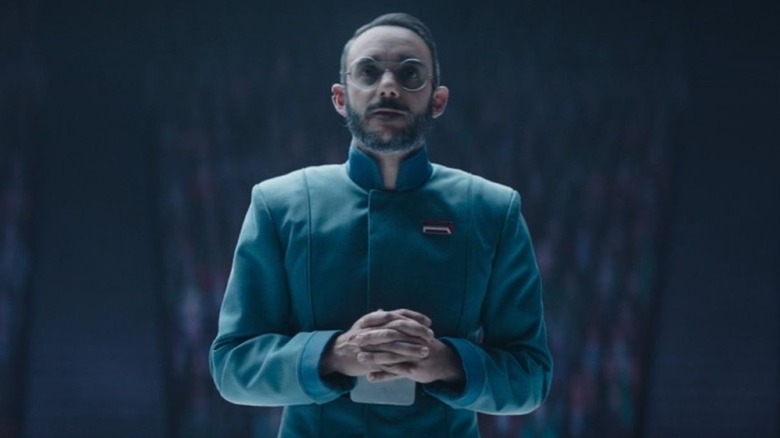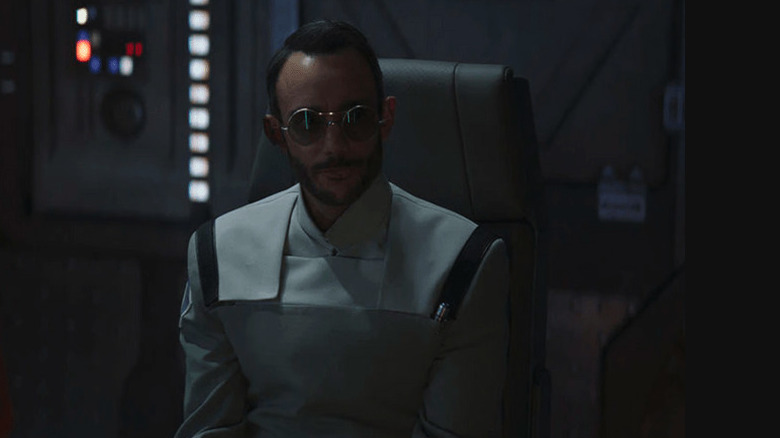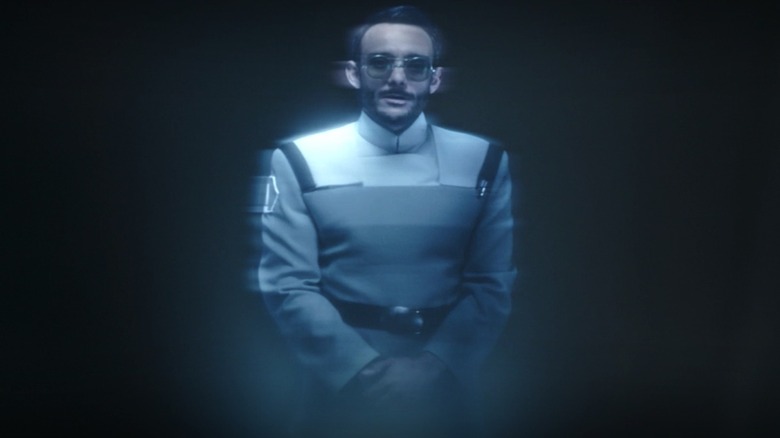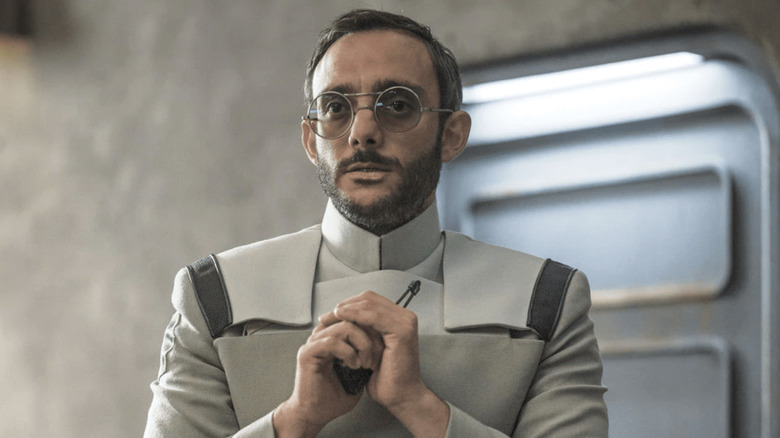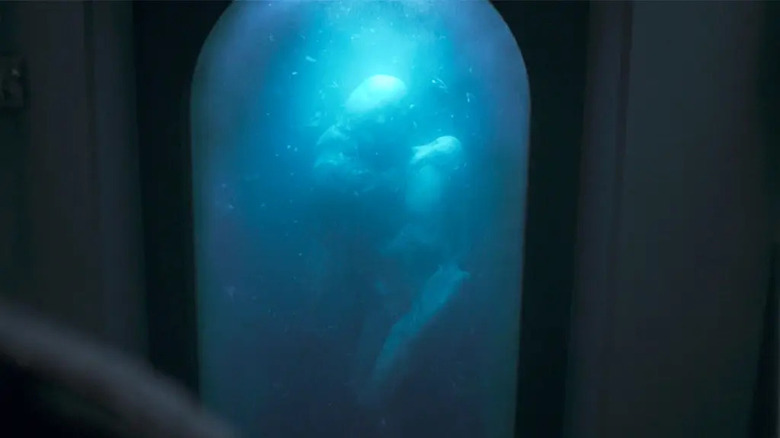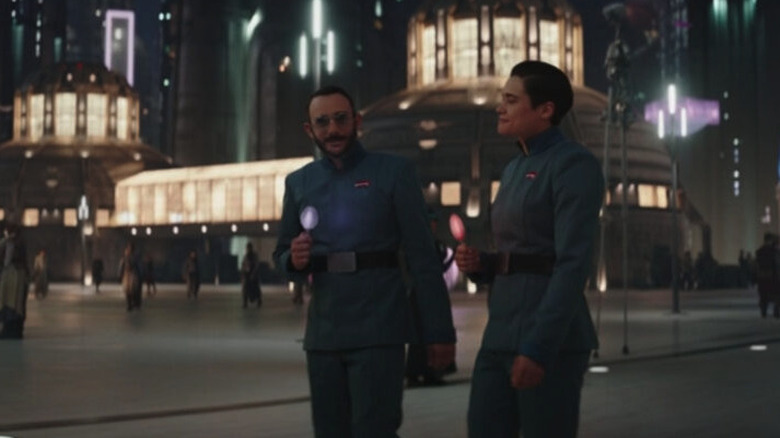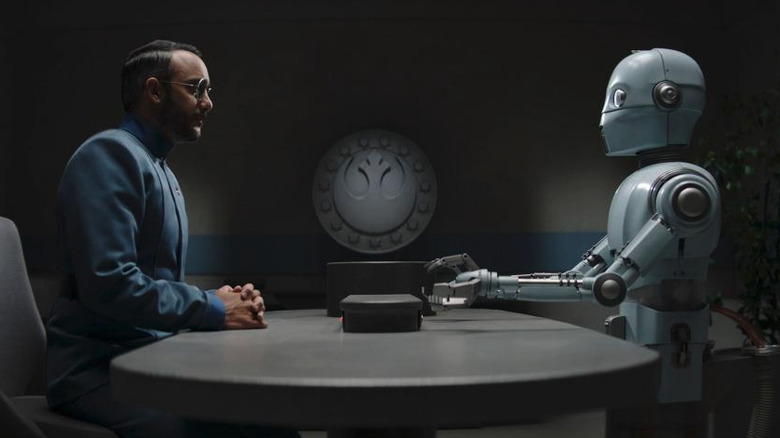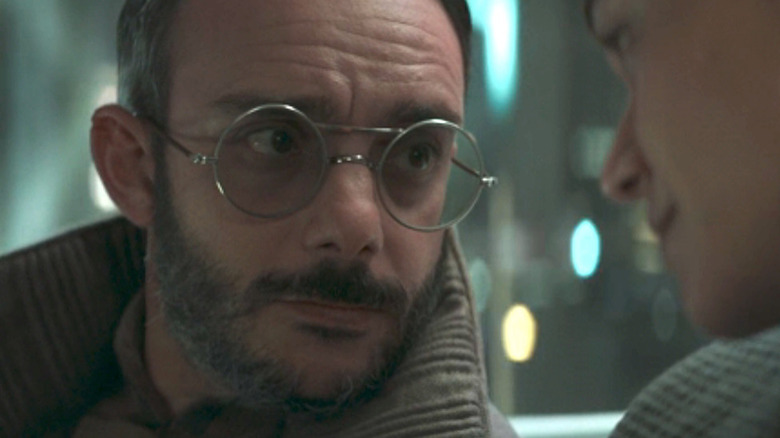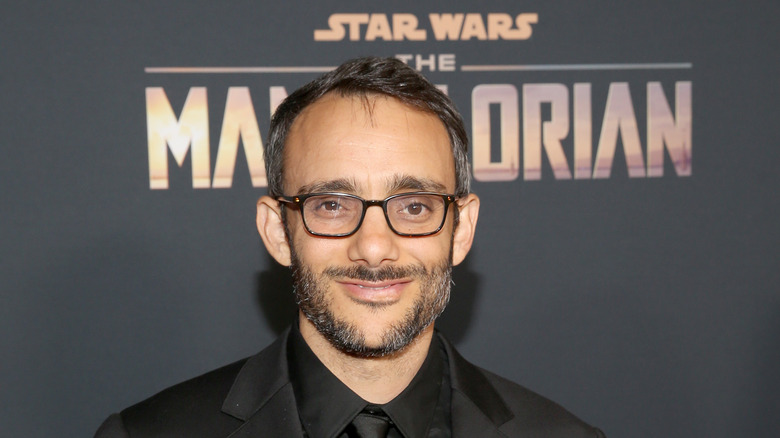The Mandalorian: Penn Pershing's Complete History Explained
"The Mandalorian" Season 3's "Chapter 19: The Convert" puts Pedro Pascal's Din Djarin in the backseat and switches gears to focus on Dr. Penn Pershing (Omid Abtahi). Though audiences haven't seen him in a while, Pershing's arc has slowly been building throughout the series.
Initially introduced in Season 1's "Chapter 1: The Mandalorian," Pershing is an unusual antagonist who Din comes up against a few times. Now that the Empire has fallen, Pershing works as a scientist for an Imperial remnant force under the supervision of Moff Gideon (Giancarlo Esposito). He is tasked with retrieving the "asset" in order to continue his experiments. However, the asset turns out to be little Grogu. Din doesn't take too kindly to Pershing's endeavors: These rogue Empire soldiers have zero interest in Grogu's well-being. But Pershing proves an exception to this rule. While he's a man of science, he doesn't want to hurt Grogu, and insists that he's kept alive and treated well — even if he is being used for experimentation. This makes Pershing an incredibly interesting character: He's clearly not a bad guy, but he's definitely doing bad things.
Pershing crosses paths with Din a number of times. The latter man has always chosen mercy when dealing with Pershing, as he knows he's not actively trying to hurt Grogu. So, when Season 3 opts to put Pershing in the driver's seat for almost an entire episode of "The Mandalorian," it's a surprise, to be sure — but a very welcome one. While Pershing may seem like a small character, his distinction has only grown in this galaxy far, far away. We're here to break down the complete history of this character, including his wider importance to the world of "Star Wars."
The death of Penn Pershing's mother
Not too much is known about Pershing's childhood or what planet he was even born on. However, we do know that he lost his mother when he was quite young. During a presentation he makes to the New Republic in "Chapter 19: The Convert," Pershing details that while living on his home world, his mother was plagued by heart failure, and that it eventually took her life. He recalls that if his countrymen had cloned organs and other medical resources available to them, she would have been spared such grievous suffering and eventual death. It was from that moment on that Pershing decided to dedicate himself towards the science of cloning, vowing that no one else would ever have to suffer as he and his mother did.
Pershing uses this story to explain why he joined the Empire and what his research entails. He believes that, thanks to the technology the Kaminoans provided during the Clone Wars, the galaxy has been given a potent glimpse of what cloning technology can truly do. In Pershing's opinion, if this technology is used by the right hands, it's capable of sparking positive change for everyone. Needless deaths like his mother's could become a thing of the past. While he may not outright say it, Pershing clearly believes that if every planet has access to the same wealth and resources, then the galaxy will transform into a fair and equal place. It is this shining ideal of unification across the universe that likely led him to join the Galactic Empire. The possibilities it offers are glittering and endless — or so he must have originally thought.
Penn Pershing joins the Empire
Led by his glowing ideals, Pershing likely joined the Empire the picture of bright-eyed and bushy-tailed enthusiasm. He believes that he can do some impactful good with the Empire at his back. As a skilled scientist, he probably moved up the ranks quite quickly; his focus on cloning likely held some serious interest to the Emperor, who used clones to control the galaxy.
Let's take a moment to brush up on the relevant history. Following the events of the Clone Wars, the Galactic Empire rose up from the ashes. Darth Sidious (Ian McDiarmid) came to power in the Galactic Senate and orchestrated the destruction of the Jedi Order. He corrupted the young Jedi protégé and proclaimed "chosen one" Anakin Skywalker (Hayden Christensen) into joining him on the dark side of the Force. Together, they restructured the Senate into the Galactic Empire, ensuring their sinister will would ripple throughout the galaxy.
The Emperor sold out all ideals of keeping peace and structure throughout the galaxy once his rule was cemented. He faced zero pushback, as, in the words of Senator Padmé Amidala (Natalie Portman), "liberty [died] with thunderous applause." In other words, the Senate was totally happy with his plans for the galaxy. People like the young and naïve Pershing idolized the shimmering dreams of peace they were presented with. Once they discovered what the Empire was truly about, it was too late. They had become part of the machine, and it showed no sign of slowing down any time soon.
The collapse of the Empire
After years of tyranny, the galaxy finally had enough of the Galactic Empire and gave birth to the Rebel Alliance. These heroes took down the Empire's rule and reinstated the Republic — at least for a short period of time. However, there are still Imperial soldiers out there fighting against the Alliance, like Moff Gideon's Imperial remnant, which is introduced in "The Mandalorian." Unfortunately for Pershing, he's part of that remnant. In fact, it's likely that he didn't have any choice but to stay with them, as his science is seemingly key to all plans to restore the Empire. As fans know, this is something that absolutely comes to pass, as the First Order emerges years later and destroys the New Republic during the "Star Wars" sequel trilogy.
While working on Moff Gideon's ship, Pershing recalls seeing Communications Officer Elia Kane (Katy M. O'Brian), who also continues to work to restore the Empire. However, the two have never spoken before. This makes sense, given how nervous and socially awkward Pershing is. It's likely that Pershing buried himself in his specific work, as that's the one thing he truly believes in, rather than the will of the Empire. Even after he's freed from Moff Gideon's reign, Pershing still holds his research regarding cloning in high esteem, suggesting that while he believes the Empire to be evil, he still wishes to return to his work. His reasons for becoming a scientist have not changed, even as everything around him has transformed.
Penn Pershing and Grogu
It's during his time working with Moff Gideon that Pershing is introduced to Grogu. Grogu, otherwise known as the Child (or Baby Yoda, by fans) is one of very few characters in the "Star Wars" story to be a member of the same mysterious species famous Jedi Master Yoda belongs to. It's revealed that Grogu was once a youngling, training at the Jedi Temple to become a Jedi Master. However, things took a dark turn once Order 66 was initiated in the clone soldiers.
Order 66 is a secret command that is embedded in all clone troopers. Once activated, it makes the clones believe that the Jedi are traitors who need to be ruthlessly killed. After it was triggered, a massive and viciously violent purge of most Jedi knights and padawans took place. Grogu survived the massacre at the Jedi Temple, but due to his species' slow aging, he's still considered to be a baby — even though he's at least 50 years old.
Since Grogu is one of the last Jedi around (who also happens to be too young to defend himself), he's the perfect target for Moff Gideon to set his sights on. When "The Mandalorian" first introduces Pershing, he's working with Din's unnamed client (Werner Herzog) on Nevarro. Din has been hired to try and find Grogu and bring him back to Pershing, so that he can continue his experiments. While it's an open contract for other bounty hunters, Pershing makes it clear that he wants Grogu alive and that no harm should come to him. Unfortunately for both Pershing and Din, other contracts don't care whether Grogu is returned dead or alive — Pershing's interest in his safety means nothing to them.
Penn Pershing's experiments
Grogu's importance to Moff Gideon can't be overstated, and it's all tied to Pershing's work on cloning. It's revealed that Pershing needs Grogu so that he can extract and clone his blood. He then has different volunteers sign up to allow him to inject them with this cloned blood. Unfortunately, it looks as though his experiments don't have the desired outcome: Most of the bodies shown in the series are disfigured and seemingly dead, or at least in an inactive state. Interestingly, they resemble another "Star Wars" character who makes his mark some time after this series takes place: Supreme Leader Snoke.
Pershing is extracting and cloning Grogu's blood because of its high midi-chlorian count. As Qui-Gon Jinn (Liam Neeson) explains in "Star Wars: Episode I — The Phantom Menace," midi-chlorians are tiny little life forms that form a somewhat symbiotic relationship with the blood of certain beings. Those with a plentiful amount of them in their system are able to connect with and harness the power of the Force. Thus far, it looks as though Pershing's experiments have been a failure, which is likely why the Imperial remnants are scattered throughout the galaxy. But if they do manage to create Force-sensitive soldiers, this would change the balance of power in favor of the Empire. This could explain how the First Order manages to take over once more.
Penn Pershing joins the amnesty program
Once Moff Gideon's troops successfully capture Grogu, Din gathers his crew together to launch a rescue mission. He comes across Pershing on board a transport ship and demands to know Grogu's whereabouts. Pershing shares that the young Jedi is alive and on board Moff Gideon's ship, and also provides the group with valuable information on how they can sneak onto the ship and attempt a rescue plan. Din opts to leave Pershing alive, which gives him a new outlook on life. Ultimately, this results in Pershing joining the New Republic's Amnesty Program.
The Amnesty Program is a rehabilitation project for former Imperials looking to make a positive change within the New Republic. Upon joining, Pershing is taken to Coruscant, the capital of the New Republic, and is placed in Amnesty Housing with a low-invasive job of destroying all Empire research.
At his new residence, he meets other Imperials who are part of the program, including Moff Gideon's communications officer, Elia Kane. The two become close, which gives Kane the opportunity to begin planting seeds of doubt in Pershing's mind as she manipulates him into wanting to take part in his research once more. The two sneak onto an old Imperial ship so that Pershing can collect the necessary tools to continue his cloning work, which he believes could vastly help the New Republic. Unfortunately for him, it's a trap that Kane has set. Pershing gets taken to receive "treatment," courtesy of a machine that will essentially flay his mind. On the low settings, it's not completely dangerous. Unfortunately, when no one is looking, Kane cranks those settings up. This insinuates that his mind will be completely wiped. She's got what she needs — the tools for his cloning research — and has no more use for him.
What happened to Penn Pershing's ear?
As part of Pershing's rehabilitation in the Amnesty Program, he's asked a series of questions about his feelings towards the New Republic. Initially, when he answers them, Pershing seems to be at peace with his situation — in fact, one could say that he's downright happy. Since joining the Amnesty Program, he's been given a platform to discuss his research, made friends, and no longer feels in danger as he once did within the Empire. However, once he begins to hang out with Kane, he starts to question his position, as he notices that his new job requires him to delete valuable scientific projects that the Empire has worked on. Pershing believes that, in the right hands, this information could help people, much like his cloning research. Once he begins to question this, all his feelings of happiness and contentment begin to falter.
The biggest sign that Pershing is beginning to question things is a blink-and-you-miss-it moment between him and the New Republic rehabilitation droid that asks him his daily questions. When the droid asks, "Have you experienced feelings of anger or resentment towards the New Republic government or its representatives?," Pershing is briefly shown touching his ear before answering no — a clear lie.
How was his ear damaged? It's the work of Cara Dune (Gina Carano), who did it as she boarded his transport ship with Din, looking for Grogu. Cara shot and killed the pilot of Pershing's ship and grazed his ear in the process, leaving it noticeably scarred. Cara is a representative of the New Republic, and this means he holds some lingering feelings of resentment towards them.
Why Penn Pershing's story is more important than you think
In the "Star Wars" sequel trilogy, the First Order picks up right where the Empire leaves off. This new dictatorship rules the galaxy under the reign of the mysterious Supreme Leader Snoke (Andy Serkis) and the corrupted son of Han and Leia, Kylo Ren (Adam Driver). The question is, how did they rise to power? Well, it seems like "The Mandalorian" might just answer this question, and it all ties into Pershing's clone research.
Following the events of Order 66, "Star Wars: The Bad Batch" outlines Palpatine's ordered destruction of Kamino, ensuring that no one else will have access to their superior cloning technology. However, before doing so, he captures one of their leading scientists and puts them to work on a special cloning project at Mount Tantiss. Fast forward a few years, and it seems like Pershing has picked up where that project left off; his uniform indicates that he's a scientist working at Mount Tantiss. However, Pershing has made a few improvements over the past years, as his research is based around creating an entirely new person using two or more people's DNA. Now, when you add the fact that he's extracting, cloning, and experimenting on Grogu's Force-sensitive blood, things start to come into focus: His research directly results in creating the First Order's Supreme Leader Snoke.
We know that Snoke is just a puppet for Palpatine, and is essentially meant to help him achieve immortality. Therefore, Palpatine's return is rendered less mysterious: Pershing's research allows him to come back. Luckily, it doesn't seem like Pershing will ever see what his research is responsible for unleashing upon the galaxy.
Who plays Penn Pershing?
Dr. Penn Pershing is portrayed by actor Omid Abtahi. You might recognize him from his eight-episode arc as Howard on "Fear the Walking Dead," or from his recurring role as Salim on "American Gods." Abtahi has also starred in various procedural cop shows, including "Castle," "The Blacklist," "NCIS: Los Angeles," and "The Mentalist," and a wide variety of other productions, ranging from "Fringe" to "Better Call Saul." The versatile actor has even dipped his toes into a number of films: Cinephiles might recognize him as Reza Borhani from 2012's "Argo," or as Homes from 2015's "The Hunger Games: Mockingjay — Part 2." You might also recognize his voice, as Abtahi has a vast range of voice acting work under his belt. He's lent his pipes to "Archer," "Star Wars: The Clone Wars," various "Call of Duty" and "World of Warcraft" games, "Titanfall 2," "Family Guy," and many more productions.
When Abtahi got the part of Pershing on "The Mandalorian," he admitted to having only ever seen one "Star Wars" film at the time: "Star Wars: The Last Jedi." Looking to prepare himself, he embarked upon a crash course in the galaxy far, far away. As the actor told Discussing Film, "I [realized] I had to go and watch them now and essentially binged it ... and fell madly in love with [the series] and I am now beating myself for waiting so long to watch it." Better late than never!
